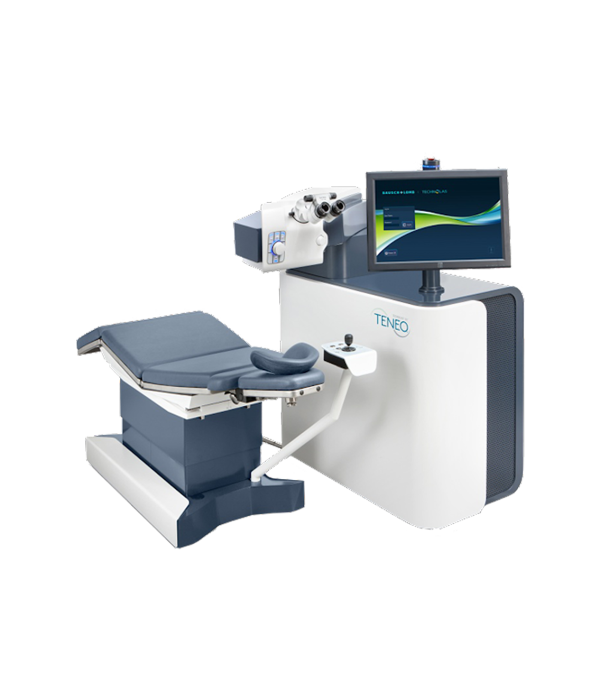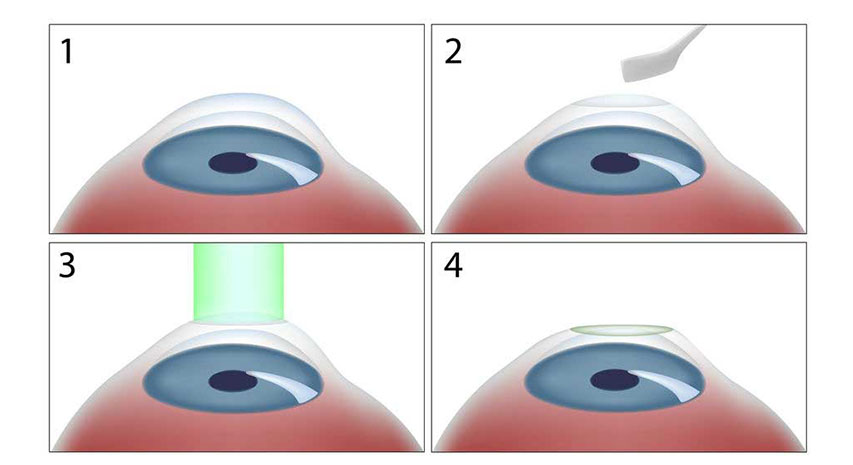Trans PRK (No touch)
Trans PRK (No touch)
There are several inherent advantages of trans-PRK over PRK that make the former a desirable procedure to use and to improve, besides the catchy “no-touch, all-laser procedure” marketing slogan. Trans-PRK is patient friendly, because there is no risk of alcohol spillage and no extra manipulation, as in mechanical debridement, thus reducing patients’ stress during the procedure. Trans-PRK also provides faster epithelial recovery due to a smaller, healthier, and neater epithelial edge, which translates to a shorter period of patient discomfort for patients. Moreover, as opposed to alcohol and mechanical debridement, laser epithelial removal ensures that no area of Bowman membrane denuded of its epithelium is left untreated by the laser, as the epithelial removal zone is calculated to match the stromal ablation zone. This is an important protective factor against epithelial erosions postoperatively.





Our Vision
- The results of trans-PRK for myopic (nearsighted) patients are equal to those for LASIK, after one month. The long-term results may even be superior to LASIK.
- There are fewer dry eyes in comparison to LASIK treatments.
- There are no flap complications, because there is no corneal flap.
- The corneal surface needs an average of 2.5 days to heal.
- After the surface heals, good vision is rapidly restored for myopic patients. Hyperopic patients may need up to 3 months for their vision to improve.
- Stabilization is often better than hyperopic-LASIK treatments.
- Using modern bandage contact lenses and topical anesthetics, the discomfort time has been reduced to 24-36 hours.
How does the No Touch Trans PRC work?
In No-Touch-Trans-PRK, the corneal epithelium is first removed using modern laser technology with the excimer laser. Unlike PRK or LASEK, this new method does not use a scraper or the mechanical method.

In the next step, the excimer laser is used to ablate the cornea by a certain thickness – based on the values measured during the preliminary examination. This changes the refractive power of the cornea in such a way that incident light rays now strike the retina correctly bundled – a sharp visual image is created.

Finally, a therapeutic contact lens is placed on the eye. The contact lens protects the eye for the first 3 to 5 days, until the epithelium has completely regressed. However, it may take two to three months for vision to become stable.

What to look for in no-touch trans PRC
The alternative procedure:
No-Touch-Trans-PRK is a further development of the classic PRK method (PhotoRefractive Keratectomy) and is significantly gentler than classic PRK (manual scraping). Nevertheless, ReLEx smile or Femto-LASIK treatment should always be preferred because they are truly painless and gentle. Only if (e.g. due to a too thin cornea) this is not possible, the No-Touch-Trans-PRK is an alternative.
- With No-Touch-Trans-PRK, a larger wound area develops following the treatment, which can lead to discomfort (such as initial pain).
- To counteract the risk of scarring (haze formation), the eyes must be treated preventively with cortisone eye drops over a longer period of time. However, flap complications cannot occur in return.
- In the case of no-touch trans-PRK, the healing process is supported by a contact lens, so that the patient must be prepared for a longer period of time until improved vision is achieved.

The Femto-LASIK method, on the other hand, guarantees:
- an almost painless healing process, and there is no scarring.
- The improved vision appears quickly.
EuroEyes usually performs this type of laser method (No-Touch-Trans-PRK) only on patients for whom ReLEx smile or Femto-LASIK is not an option due to a very thin cornea or for professional reasons. Treatment options of No-Touch-Trans-PRK is limited. Thus, as a rule, only myopia up to max. -6 dpt and astigmatism up to max. -3 dpt can be corrected. The correction of farsightedness is not possible.
Everything you need to know aboutthe No Touch
Trans PRC process.
1. personal, non-binding consultation
- Measurement of all relevant eye parameters
- Checking whether your eyes are suitable for the procedure
- Determination of the best treatment procedure for your eyes

2. comprehensive preliminary medical examination
- Duration of examination usually 1 1/2 to 2 hours
- Intensive preliminary ophthalmological examination and measurement of your eyes
- Detailed treatment explanation by specialist
- Before this appointment you are not allowed to wear soft contact lenses for one week and hard contact lenses for two weeks.
- Please note that you are not allowed to drive any vehicle after the examination – neither car, nor motorcycle or bicycle. We therefore recommend using public transport or taking a cab
- You will receive an aftercare kit for the days following your treatment. The contents Is there an age limit for laser eye treatments?and medications will be explained to you in detail by our staff.

3. on the day of your no-touch trans-PRK treatment.
- We recommend that you wear comfortable clothing on the day of treatment
- You can eat and drink regularly on the treatment day, please do not smoke
- For hygiene reasons, it is important that you wash your face thoroughly before the treatment, remove makeup completely and avoid wearing perfume
- Anesthesia with drops
- Outpatient procedure, no eye bandage, sunglasses recommended
- Total duration of the surgery (both eyes): Approx. 25 min.
- After the treatment you are not allowed to drive a vehicle

4. after the no touch trans PRK operation.
- Please do not rub your eyes
- The doctor will discuss with you in advance the administration of artificial tear substitute, the combination preparation, which has a preventive effect against swelling and inflammation, as well as pain eye drops.
- Professional activity after 1-2 weeks
- Sports activities, as well as swimming and sauna after about 2 weeks
- Check-ups: two days, four days, one week, two weeks, one month, two months and three months after surgery
- Driving is allowed again only after the permission of the doctor

FREQUENT QUESTIONS ABOUT NO-TOUCH-TRANS-PRK
Generally, we perform laser treatment until about the age of 50. When presbyopia sets in, around the age of 45, correction with a multifocal lens (trifocal lens) is usually more suitable. We will discuss this with you during the preliminary examination.
Halos at night
Epithelial closure delayed
Haze formation
The laser eye treatment takes place in front of the eye on the cornea. Thus, it has no effect on possible cataract treatment and other surgeries.
Your values should be stable for about one year before treatment. If in doubt, come to us and we will check your visual acuity conscientiously.

